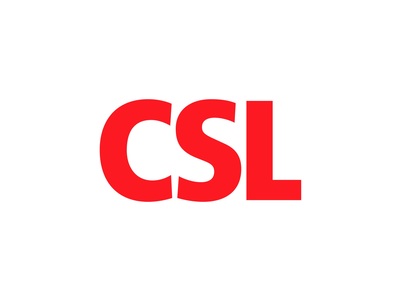CSL Behring's HEMGENIX® (etranacogene dezaparvovec-drlb) Demonstrates at Three Years Post-Treatment Long-Term Durability, Safety and Greater Bleed Protection Versus Prophylactic Treatment in People Living with Hemophilia B
- HEMGENIX® is the first and only gene therapy approved by the
U.S. Food and Drug Administration (FDA) for the treatment of hemophilia B and to show sustained efficacy and safety at three years post-treatment - Long-term data continues to show a one-time infusion of HEMGENIX offers elevated and sustained factor IX activity levels for years and significantly reduces the rate of annual bleeds versus factor IX prophylaxis with a favorable safety profile
- At three years post-treatment with HEMGENIX,
94% of patients remained free of continuous prophylactic treatment
"The long-term follow-up data from the HOPE-B study reinforces that a one-time treatment with HEMGENIX can produce elevated and sustained factor IX levels and reduce the rate of annual bleeds for years in people living with hemophilia B," said Dr. Steven Pipe, Professor of Pediatrics and Pathology at the University of
The Phase III, open label, single-dose, single arm HOPE-B trial included 54 male participants with severe or moderately severe hemophilia B with or without pre-existing AAV5 neutralizing antibodies. Of the 54 participants who received HEMGENIX, 52 completed three years of follow-up. HEMGENIX produced mean factor IX levels of 41.5 IU/dL at year one, 36.7 IU/dL at year two and 38.6 IU/dL at year three post-treatment. In addition,
The three-year data also demonstrated that the mean annualized bleeding rate (ABR) for all bleeds was reduced by
There were no serious adverse events related to treatment with HEMGENIX. HEMGENIX was generally well-tolerated, with most treatment-emergent adverse events (
"Gene therapy is a novel treatment that addresses unmet needs in the hemophilia B community and the data presented at ASH continues to provide confidence in the clinical benefits of HEMGENIX," said Steven Pascoe, M.D., Chief Medical Officer, CSL. "As part of our commitment to the hemophilia B community, we will continue to follow the participants from the HOPE-B study as well as those who have been treated with HEMGENIX post FDA approval to generate additional evidence supporting the long-term safety, efficacy and durability of this one-time treatment. We encourage healthcare professionals to continue to have open conversations with their patients about individual treatment goals and whether HEMGENIX may be an appropriate treatment option."
In addition to the presentation of the three-year results of the HOPE-B trial, two posters on HEMGENIX were presented evaluating HEMGENIX in patients with comorbidities. The first (Abstract #2258) assessed HEMGENIX in hemophilia B patients with a history of chronic hepatitis C and hepatitis B infections and the second (Abstract #2256) investigated those with human immunodeficiency virus (HIV). Additionally, an analysis on the indirect treatment comparison of HEMGENIX and factor IX prophylaxis was recently published in Haemophilia.
HEMGENIX also has been granted conditional marketing authorization by the European Commission (EC) for the European Union and European Economic Area, and the
For more information on HEMGENIX, please visit www.Hemgenix.com.
About the Pivotal HOPE-B Trial
The pivotal Phase III HOPE-B trial is an ongoing, multinational, open-label, single-arm study to evaluate the safety and efficacy of HEMGENIX. Fifty-four adult hemophilia B patients classified as having moderately severe to severe hemophilia B and requiring prophylactic factor IX replacement therapy were enrolled in a prospective, six-month or longer observational period during which time they continued to use their current standard of care therapy to establish a baseline Annual Bleeding Rate (ABR). After at least the six-month lead-in period, patients received a single intravenous administration of HEMGENIX at the 2x10^13 gc/kg dose. Patients were not excluded from the trial based on pre-existing neutralizing antibodies (NAbs) to AAV5.
A total of 54 patients received a single dose of HEMGENIX in the pivotal trial, with 52 patients completing at least three years of follow-up. The primary endpoint in the pivotal HOPE-B study was ABR 52 weeks after achievement of stable factor IX expression (months 7 to 18) compared with the six-month lead-in period. For this endpoint, ABR was measured from month seven to month 18 after infusion, ensuring the observation period represented a steady-state factor IX transgene expression. Secondary endpoints included assessment of factor IX activity.
No serious treatment-related adverse reactions were reported. One death resulting from urosepsis and cardiogenic shock in a 77-year-old patient at 65 weeks following dosing was considered unrelated to treatment by investigators and the company sponsor. A serious adverse event of hepatocellular carcinoma was determined to be unrelated to treatment with HEMGENIX by independent molecular tumor characterization and vector integration analysis. No inhibitors to factor IX were reported.
Long-term three-year data presented at the 65th American Society of Hematology (ASH) 2023 Annual Meeting and Exposition continue to reinforce the potential long-lasting efficacy and safety of HEMGENIX and the ongoing benefit of this treatment for people living with hemophilia B.
About Hemophilia B
Hemophilia B is a life-threatening rare disease caused by a mutation on the F9 gene, resulting in low levels of functional clotting factor IX. People with the condition are particularly vulnerable to bleeds in their joints, muscles, and internal organs, leading to pain, swelling, and joint damage. Current treatments for moderate to severe hemophilia B include life-long prophylactic infusions of factor IX to temporarily replace or supplement low levels of the blood-clotting factor.
About HEMGENIX®
HEMGENIX is a gene therapy that reduces the rate of abnormal bleeding in eligible people with hemophilia B by enabling the body to continuously produce factor IX, the deficient protein in hemophilia B. It uses AAV5, a non-infectious viral vector, called an adeno-associated virus (AAV). The AAV5 vector carries the Padua gene variant of Factor IX (FIX-Padua) to the target cells in the liver, generating factor IX proteins that are 5x-8x more active than normal. These genetic instructions remain in the target cells, but generally do not become a part of a person's own DNA. Once delivered, the new genetic instructions allow the cellular machinery to produce stable levels of factor IX.
Important Safety Information (ISI)
What is HEMGENIX®?
HEMGENIX®, etranacogene dezaparvovec-drlb, is a one-time gene therapy for the treatment of adults with hemophilia B who:
- Currently use Factor IX prophylaxis therapy, or
- Have current or historical life-threatening bleeding, or
- Have repeated, serious spontaneous bleeding episodes.
HEMGENIX is administered as a single intravenous infusion and can be administered only once.
What medical testing can I expect to be given before and after administration of HEMGENIX?
To determine your eligibility to receive HEMGENIX, you will be tested for Factor IX inhibitors. If this test result is positive, a retest will be performed 2 weeks later. If both tests are positive for Factor IX inhibitors, your doctor will not administer HEMGENIX to you. If, after administration of HEMGENIX, increased Factor IX activity is not achieved, or bleeding is not controlled, a post-dose test for Factor IX inhibitors will be performed.
HEMGENIX may lead to elevations of liver enzymes in the blood; therefore, ultrasound and other testing will be performed to check on liver health before HEMGENIX can be administered. Following administration of HEMGENIX, your doctor will monitor your liver enzyme levels weekly for at least 3 months. If you have preexisting risk factors for liver cancer, regular liver health testing will continue for 5 years post-administration. Treatment for elevated liver enzymes could include corticosteroids.
What were the most common side effects of HEMGENIX in clinical trials?
In clinical trials for HEMGENIX, the most common side effects reported in more than
What should I watch for during infusion with HEMGENIX?
Your doctor will monitor you for infusion-related reactions during administration of HEMGENIX, as well as for at least 3 hours after the infusion is complete. Symptoms may include chest tightness, headaches, abdominal pain, lightheadedness, flu-like symptoms, shivering, flushing, rash, and elevated blood pressure. If an infusion-related reaction occurs, the doctor may slow or stop the HEMGENIX infusion, resuming at a lower infusion rate once symptoms resolve.
What should I avoid after receiving HEMGENIX?
Small amounts of HEMGENIX may be present in your blood, semen, and other excreted/secreted materials, and it is not known how long this continues. You should not donate blood, organs, tissues, or cells for transplantation after receiving HEMGENIX.
Please see full prescribing information for HEMGENIX.
You are encouraged to report negative side effects of prescription drugs to the FDA. Visit www.fda.gov/medwatch, or call 1-800-FDA-1088.
You can also report side effects to CSL Behring's Pharmacovigilance Department at 1-866-915-6958.
About CSL
CSL (ASX:CSL; USOTC:CSLLY) is a global biotechnology company with a dynamic portfolio of lifesaving medicines, including those that treat haemophilia and immune deficiencies, vaccines to prevent influenza, and therapies in iron deficiency and nephrology. Since our start in 1916, we have been driven by our promise to save lives using the latest technologies. Today, CSL – including our three businesses: CSL Behring, CSL Seqirus and CSL Vifor – provides lifesaving products to patients in more than 100 countries and employs 32,000 people. Our unique combination of commercial strength, R&D focus and operational excellence enables us to identify, develop and deliver innovations so our patients can live life to the fullest. For inspiring stories about the promise of biotechnology, visit CSL.com/Vita and follow us on Twitter.com/CSL.
For more information about CSL, visit CSL.com.
Media Contacts
Etanjalie Ayala
Mobile: +1 610 297 1069
Email: etanjalie.ayala@cslbehring.com
Maria Tortoreto
Mobile: +1 201 248 5208
Email: maria.tortoreto@cslbehring.com
![]() View original content to download multimedia:https://www.prnewswire.com/news-releases/csl-behrings-hemgenix-etranacogene-dezaparvovec-drlb-demonstrates-at-three-years-post-treatment-long-term-durability-safety-and-greater-bleed-protection-versus-prophylactic-treatment-in-people-living-with-hemophilia-b-302011606.html
View original content to download multimedia:https://www.prnewswire.com/news-releases/csl-behrings-hemgenix-etranacogene-dezaparvovec-drlb-demonstrates-at-three-years-post-treatment-long-term-durability-safety-and-greater-bleed-protection-versus-prophylactic-treatment-in-people-living-with-hemophilia-b-302011606.html
SOURCE CSL








